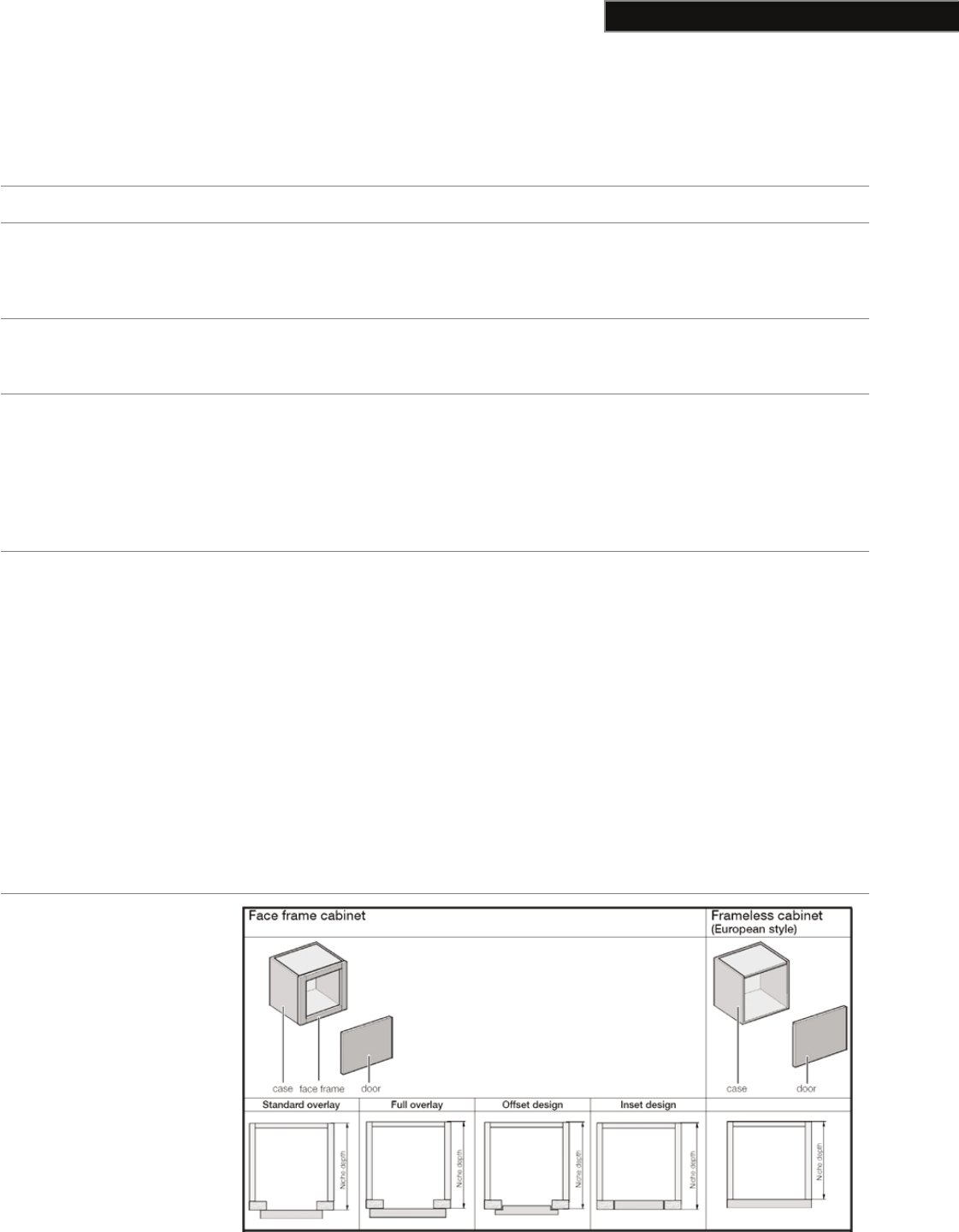
Kitchen design — basic terms.
To clarify the terms which are used in this planning guide, please refer to the following denitions:
Case
This is the main body of a kitchen cabinet.
Face Frame (Cabinet)
This is a decorative frame at the front of a kitchen cabinet and is typical for North
America. Variations by manufacturer in kitchen design construction may purposely
have a clearly visible face frame that is a part of the kitchen aesthetics. European
design and styling of cabinets (frameless cabinetry) typically do not have a frame.
Door
The kitchen cabinetry door panel is the element of kitchen furniture largely dening
the aesthetic design of a kitchen. It can have any conceivable look — from modern to
traditional. In this planning guide a ¾" (19 mm) thick door panel is presumed.
Appliance Door Panel
The modular refrigerator and freezer columns from Gaggenau are intentionally
designed to be equipped and delivered with custom made appliance door panels
that perfectly match the end-user‘s installed kitchen cabinetry. Typically the normal
appliance door panel thickness is expected to be ¾" (19 mm). However, a thicker
appliance door panel can be accommodated if such door panels are used on the
end-user‘s kitchen cabinetry or in order to emulate the look of the visible face frame
(addition to the door) on the refrigerator as well.
Cutout (Niche)
The cutout is the cavity where a Gaggenau refrigerator or freezer is installed. The
width of the cutout (18",24",30",..) is dependent on the appliance. The cutout depth
is equal to the depth of the kitchen cabinet (case+face frame). It does NOT include
the thickness of the cabinetry door panel. For proper planning of the cutout depth,
please refer to the respective chapter on page 180 in this planning guide.
The main idea of the Gaggenau modular refrigerator and freezer column concept
is, that you can simply replace any standard size kitchen cabinet with a refrigerator
column. You can create a suitable cutout by leaving a respective gap between two
tall cabinets. Alternatively you may create an enclosure, that the appliance will t into.
However this is not the original design intent (basic idea).
When planning the installation cutout, it is important that the side walls are complete-
ly ush! Please make sure that there is not any kind of face frame at the front of the
cutout. If, for some reason this is not the situation, please make sure that the depth of
this face frame (furniture return) is more than 4" (100 mm) so that the appliances can
be properly secured.
Kitchen Cabinetry
Illustration
Kitchen Design
–
Basic Terms
To clarify the terms which are used in this quick reference, please refer to the following definitions:
This is the main body of a kitchen cabinet.
This is a decorative frame at the front of a kitchen cabinet and is typical for North America.
Variations by manufacturer in kitchen design construction may purposely have a clearly
visible face frame that is a part of the kitchen aesthetics. European design and styling of
cabinets (frameless cabinetry) typically do not have a frame.
The kitchen cabinetry door panel is the element of kitchen furniture largely defining the
aesthetic design of a kitchen. It can have any conceivable look – from modern to traditional.
In this quick reference a
3
/
4
" (19 mm) thick door panel is presumed.
The modular refrigerator and freezer columns from Gaggenau are intentionally designed to
be equipped and delivered with custom made appliance door panels that perfectly match
the end-user‘s installed kitchen cabinetry. Typically the normal appliance door panel thickness
is expected
to be
3
/
4
"
(19 mm).
However, a thicker appliance door panel can be accommodated
if such door
panels are used on the end-user‘s kitchen cabinetry or in order to emulate the
look of the visible face frame (addition to the door) on the refrigerator as well.
The niche is the cavity where a Gaggenau refrigerator or freezer is installed. The width of the
niche (18",24",30",....) is dependent on the appliance. The niche depth is equal to the
depth of the kitchen cabinet (case+face frame). It does NOT include the thickness of the
cabinetry door panel. For proper planning of the niche depth, please refer to the
respective chapter on page 16 in this quick reference.
The main idea of the Gaggenau modular refrigerator and freezer column concept is, that you
can simply replace any standard size kitchen cabinet with a refrigerator column. You c
an
create a suitable niche by leaving a respective gap between two tall cabinets. Alternatively
you may create an enclosure, that the appliance will fit into. However this is not the original
design intent (basic idea).
When planning the installation niche, it is important that the side walls are completely flush!
Please make sure that there is not any kind of face frame at the front of the niche. If, for
some reason this is not the situation, please make sure that the depth of this face frame
(furniture return) is more than 4" (100 mm) so that the appliances can be properly secured.
Case
Face Frame
Door
Appliance Door Panel
Niche
(Installation Cavity)
Kitchen Cabinetry
Illustration
14
Refrigeration 175


















